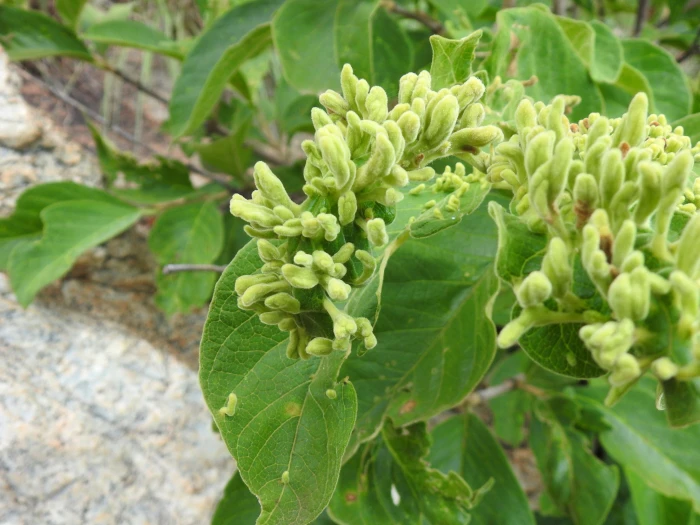African Medlar
(Vangueria infausta)
African Medlar (Vangueria infausta)
/
/

Matthew Fainman
CC BY 4.0
Image By:
Matthew Fainman
Recorded By:
Copyright:
CC BY 4.0
Copyright Notice:
Photo by: Matthew Fainman | License Type: CC BY 4.0 | License URL: http://creativecommons.org/licenses/by/4.0/ | Rights Holder: Matthew Fainman | Publisher: iNaturalist | Date Created: 2021-01-10T10:10:24-08:00 |













Estimated Native Range
Climate Requirements for Elkridge, Maryland
| This Plant | Your Site | Plant Suitability for Your Location | ||
|---|---|---|---|---|
| • Precipitation | 12" - 90" | 44" | Aquatic | Aquatic |
| • High Temp. | 73°F - 100°F | 88°F | Your summer temperatures are normal for this plant. | Excellent |
| • Low Temp. | 31°F - 74°F | 24°F | Your winter temperatures may be too cold for this plant | Too cold |
This plant may not grow well at your location - your precipitation is too high.
Summary
Vangueria infausta, commonly known as African medlar, is a deciduous small tree or large shrub native to savanna woodlands, bushveld, and riverine areas in southern and eastern Africa. It typically grows to a height of 16-23 feet (5-7 meters) and has a spreading crown. The African medlar is characterized by its dark green, glossy leaves and small, white to greenish-yellow flowers that bloom from September to November. The flowers are not particularly showy but are followed by the notable tan-colored, plum-like fruits which ripen to a yellow-brown and have a pleasant apple-like flavor. These fruits are usually harvested from May to July and are a source of food for local wildlife, including birds, as well as goats and game animals.
The African medlar is valued for its edible fruits, which are consumed fresh or used to make jams and drinks. It is also used in traditional medicine to treat a variety of ailments. In cultivation, it prefers full sun to partial shade and is adaptable to different soil types, provided they are well-drained. The tree is drought-tolerant once established, making it suitable for xeriscaping and low-water gardens. It can be used in reforestation projects and as an ornamental tree in larger gardens or parks. While generally pest-free, it can be susceptible to root rot in overly wet conditions.CC BY-SA 4.0
The African medlar is valued for its edible fruits, which are consumed fresh or used to make jams and drinks. It is also used in traditional medicine to treat a variety of ailments. In cultivation, it prefers full sun to partial shade and is adaptable to different soil types, provided they are well-drained. The tree is drought-tolerant once established, making it suitable for xeriscaping and low-water gardens. It can be used in reforestation projects and as an ornamental tree in larger gardens or parks. While generally pest-free, it can be susceptible to root rot in overly wet conditions.CC BY-SA 4.0
Plant Description
- Plant Type: Shrubs, Trees
- Height: 6-25 feet
- Width: 6-25 feet
- Growth Rate: Moderate
- Flower Color: Green
- Flowering Season: Spring
- Leaf Retention: Deciduous
Growth Requirements
- Sun: Full Sun, Part Shade
- Water: Medium
- Drainage: Fast, Medium
Common Uses
Bee Garden, Edible*Disclaimer: Easyscape's listed plant edibility is for informational use. Always verify the safety and proper identification of any plant before consumption., Low Maintenance
Natural Habitat
Native to savanna woodlands, bushveld, and riverine areas in southern and eastern Africa
Other Names
Common Names: Wild Medlar , Transvaal Medlar , African Medlar
Scientific Names: Vangueria infausta , Canthium infaustum
GBIF Accepted Name: Vangueria infausta